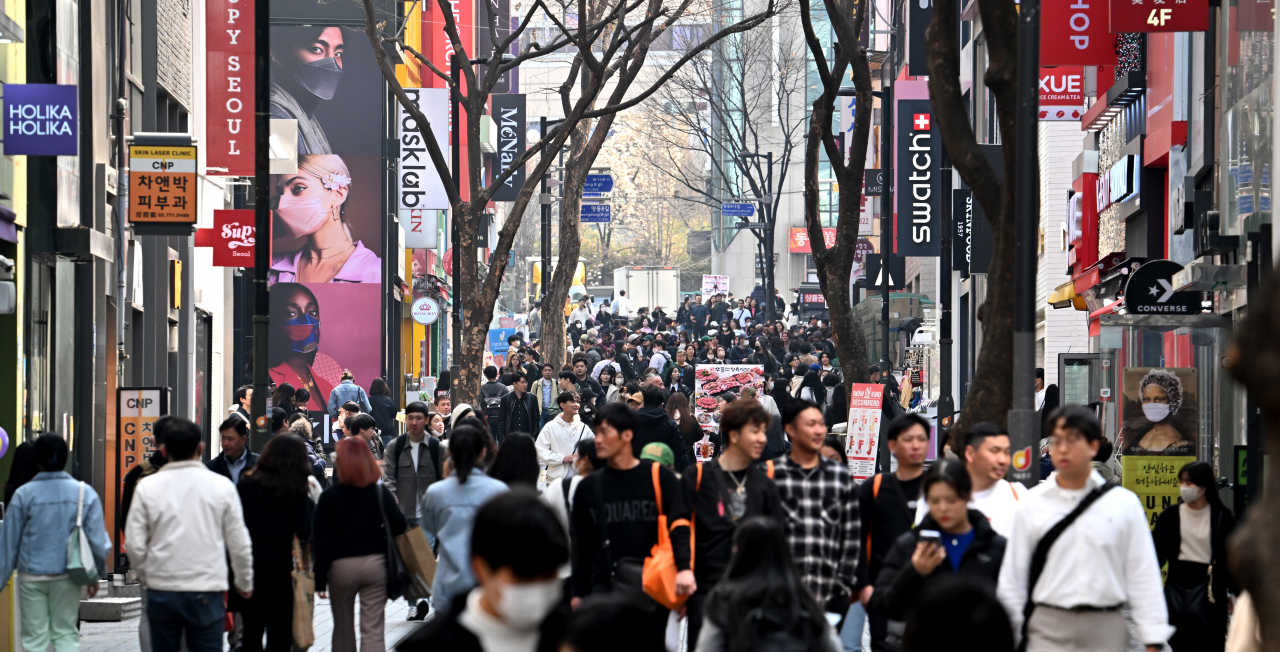 |
People walk on the main street in the Myeong-dong area, Seoul, on April 1. (Im Se-jun/The Korea Herald) |
The Chinese government has decided to allow group tours to South Korea after a six-year hiatus instigated by diplomatic bickering between Seoul and Beijing, as well as the COVID-19 pandemic.
China's Ministry of Culture and Tourism on Thursday said it would lift restrictions on its nationals to travel in groups to 78 countries around the world, including Korea, the United States and Japan.
The ban on Chinese group tours to Korea was removed for the first time since it was put in place as a retaliatory measure over Korea’s installation of a US anti-missile system, known as the Terminal High Altitude Area Defense, in March 2017. The THAAD deployment had been strongly advocated for by Washington and opposed by Beijing.
China previously lifted restrictions on group tours to 20 countries, including Thailand and Indonesia, following the abandonment of its “zero COVID” policy in January this year. It also allowed group tours to 40 countries including Nepal, Vietnam, Iran, Jordan, France, Spain and Brazil in March.
The decision by the Chinese government gives some breathing room for the Korean economy, which has been struggling to recover with China's reopening showing limited effects on the lagging tourism and export industries.
On the news, Korean air carriers are cautiously considering expanding the number of flights on Chinese routes.
Jeju Air, the country's leading budget carrier, has already started increasing flights to China, and is considering further additions.
“The expansion is being reviewed positively, but it is difficult to increase routes right away after the lifting of restrictions, as it typically takes more than two to three months to reopen new or halted routes,” a Jeju Air official said.
Lotte Duty Free, which saw its operating loss widen last year due to the prolonged COVID-19 lockdown in China, said the lifting of the tourism restriction was “encouraging,” but it would take some time for Korean companies to see the purchasing power of Chinese tourists.
“Realistically, I think it will be around the middle of the fourth quarter when the performance will start to improve to some extent. It takes about two to three months for Chinese tourism companies to make travel products, attract customers and actually bring them to Korea,” a Lotte Duty Free official said.
Chinese tourists accounted for over 40 percent of inbound visitors before the restriction was placed.
According to the Korean Tourism Organization, the proportion of Chinese travelers to the total number of visitors to Korea increased every year to 43.3 percent in 2014, 45.2 percent in 2015, and 46.8 percent in 2016, but fell to 31.3 percent in 2017. The figure nosedived to 12 percent in the first half of this year.
Korean cosmetics giant LG Household & Health Care is mapping out marketing plans to welcome Chinese tourists after suffering losses in the Chinese market amid the fizzling K-beauty boom.
"We are preparing for producing leaflets in Chinese language, discussions with distributors on additional benefits by purchase amount, promotion of new products, customized item packages for each customer type like group tourists and small-scale merchants," a company official said.
Stocks of Korean airlines and tourism soared on reports China will allow group tours to the country.
The share price of Lotte Tour Development surged over 29.99 percent compared to the previous trading day. Asiana Airlines advanced 9.42 percent and Korea Airlines climbed 2.9 percent.
Hotel Shilla, the duty free shop operator, spiked 17.3 percent, while Hana Tour gained 10 percent.







![[Weekender] Korea's traditional sauce culture gains global recognition](http://res.heraldm.com/phpwas/restmb_idxmake.php?idx=644&simg=/content/image/2024/11/21/20241121050153_0.jpg)